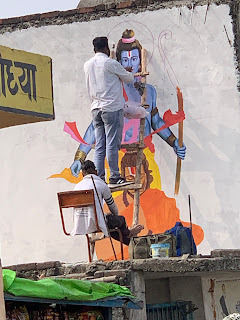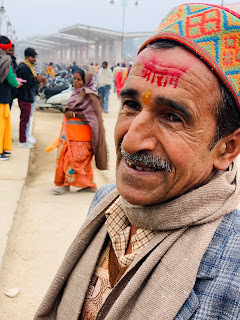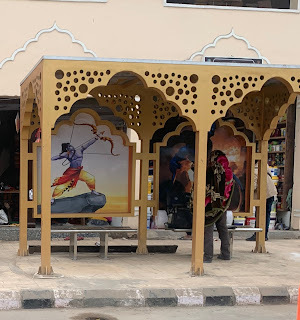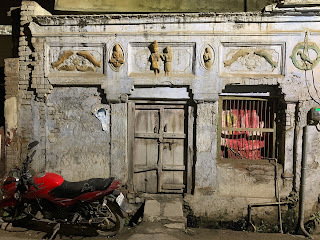Travels in India in the Year of the Ram Mandir
 "Jai Shri Ram!" All day long, the cry surfaces and reverberates in Ayodhya. It is the rallying call of the public along the wide walkway leading from the main road to the Ram Janambhoomi temple complex, hazy with construction dust and lined by workers with electric drills installing large pink concrete panels to screen off the mottled facades of the decrepit buildings on either side. It erupts with particular intensity among the shoals of devotees as they jostle on the narrow steps leading up to the Hanuman Garhi temple. It is spoken more gently after the moving morning aarti, offered to statues of Ram and Sita swaying gently on a swing, in the courtyard of the hundred-year-old Amava Ram temple with its crest of a giant bow -- and inside, its own glass-walled shrine to Ram Lalla, installed in the immediate wake of the Supreme Court judgment of 2019 -- where people gather in long rows at lunchtime a generous lunch of rice, dal, pooris and sabji provided for free by the temple's Ram Rasoi.
"Jai Shri Ram!" All day long, the cry surfaces and reverberates in Ayodhya. It is the rallying call of the public along the wide walkway leading from the main road to the Ram Janambhoomi temple complex, hazy with construction dust and lined by workers with electric drills installing large pink concrete panels to screen off the mottled facades of the decrepit buildings on either side. It erupts with particular intensity among the shoals of devotees as they jostle on the narrow steps leading up to the Hanuman Garhi temple. It is spoken more gently after the moving morning aarti, offered to statues of Ram and Sita swaying gently on a swing, in the courtyard of the hundred-year-old Amava Ram temple with its crest of a giant bow -- and inside, its own glass-walled shrine to Ram Lalla, installed in the immediate wake of the Supreme Court judgment of 2019 -- where people gather in long rows at lunchtime a generous lunch of rice, dal, pooris and sabji provided for free by the temple's Ram Rasoi. And even closer to the new Ram Mandir, it sounds thrice a day inside the small temporary shrine for Ram Lalla set up in 2020, approached through a winding barred corridor after multiple security checks, after the aartis of morning, afternoon and evening to which only 30 people are admitted by a very democratic first-come-first-served system. When after several attempts I manage to land an aarti pass, several family members send me WhatsApp messages of congratulation.
 Many people on the streets, and almost all those walking on the Ram Janambhoomi Path to gaze at the new temple complex from afar, have the words "Shri Ram" or "Sitaram" stencilled on their foreheads in red on a base of yellow. This is the one mark of uniformity connecting a thrillingly diverse array of tongues -- Hindi, Avadhi and Bhojpuri; Marathi and Gujarati; Telugu and Tamil -- dressing styles, and faces on Ram Janambhoomi Path. A substantial share of them are the weathered, statuesque faces of old India -- people who seem to have dipped their feet only lightly in the waters of modernity, and appear to possess a correspondingly large store of psychic space for the adoration of Ram and the moral universe of the Ramayana.
Many people on the streets, and almost all those walking on the Ram Janambhoomi Path to gaze at the new temple complex from afar, have the words "Shri Ram" or "Sitaram" stencilled on their foreheads in red on a base of yellow. This is the one mark of uniformity connecting a thrillingly diverse array of tongues -- Hindi, Avadhi and Bhojpuri; Marathi and Gujarati; Telugu and Tamil -- dressing styles, and faces on Ram Janambhoomi Path. A substantial share of them are the weathered, statuesque faces of old India -- people who seem to have dipped their feet only lightly in the waters of modernity, and appear to possess a correspondingly large store of psychic space for the adoration of Ram and the moral universe of the Ramayana. The traveller looks at the faces around him and thinks: our paths will likely never cross again. When a boy comes running up and offers to stencil Ram on my forehead for 10 rupees, I do not refuse the badge of the moment. The stencils are themselves part of a giant new economy of Ram paraphernalia flooding the puja samagri shops of the city: wooden replicas of the new Ram Mandir, Jai Shri Ram plaques, Jai Shri Ram ballpoint pens, Jai Shri Ram car dashboard standees, Hanuman maces, Jai Shri Ram pennants, and Jai Shri Ram charan padukas.
 All temple towns have two orders of reality: the shabby and clamorous world of the lok, and the ethereal and consoling universe of the dev lok. Ayodhya feels like it has three: the newest layer resembles a film set of an unsubtle blockbuster. The shutters of shops for several kilometres on the road from Faizabad to Mangeshkar Chowk are now painted with saffron trishuls, maces, and bows. New bus shelters broadcast pictures of Ram about to let fly an arrow. On the ghats of Ram ki Paidi can be heard the belligerent beat of Hindutva pop (including the hit "Yeh Rama Lalla Ka Dera Hai" by Shahnaaz Akhtar) blaring from loudspeakers to go with the traditional bhajans and kirtans. And there are locals kitted out as Ram, Lakshmana and Sita by TV channels keen to provide a dash of theatre to their debate stages.
All temple towns have two orders of reality: the shabby and clamorous world of the lok, and the ethereal and consoling universe of the dev lok. Ayodhya feels like it has three: the newest layer resembles a film set of an unsubtle blockbuster. The shutters of shops for several kilometres on the road from Faizabad to Mangeshkar Chowk are now painted with saffron trishuls, maces, and bows. New bus shelters broadcast pictures of Ram about to let fly an arrow. On the ghats of Ram ki Paidi can be heard the belligerent beat of Hindutva pop (including the hit "Yeh Rama Lalla Ka Dera Hai" by Shahnaaz Akhtar) blaring from loudspeakers to go with the traditional bhajans and kirtans. And there are locals kitted out as Ram, Lakshmana and Sita by TV channels keen to provide a dash of theatre to their debate stages.Under the grey winter skies of January, then, Ayodhya -- already steeped in the language and lore of Ram -- awaits its tryst with destiny. Will the city be able to bear the weight of aspirations suddenly invested in it? After all, almost overnight the actual residents of Ayodhya are fated to become a minority in their own city. Millions of Indians and NRIs, not to mention the ruling party and most of the mass media, are avid to transform themselves into Ayodhyavasis, as perhaps they were not to become the self-ruling, difference-cherishing people of a republic, reminded by Gandhi (always such a pressuring soul, and especially towards Hindus) that real ramrajya begins within oneself, that it requires great introspection and the abjuring of violence.
That privilege, that legacy -- which for decades seemed a great gift -- now seems banal when compared to the chance to be the fervid, righteous praja of a new state and a new epoch, the fortunate generation chosen by Lord Ram to restore order and purity, a single source of authority, to a mongrel millennium.
 Amidst the hail of Jai Shri Rams! in Ayodhya, one hears the murmur of the mild-mannered old town saying goodbye to itself. Its destiny is to be the beacon of a renaissance: to make India Hindu and epic again.
Amidst the hail of Jai Shri Rams! in Ayodhya, one hears the murmur of the mild-mannered old town saying goodbye to itself. Its destiny is to be the beacon of a renaissance: to make India Hindu and epic again.
Published on January 19, 2024 19:03
No comments have been added yet.
Chandrahas Choudhury's Blog
- Chandrahas Choudhury's profile
- 25 followers
Chandrahas Choudhury isn't a Goodreads Author
(yet),
but they
do have a blog,
so here are some recent posts imported from
their feed.



